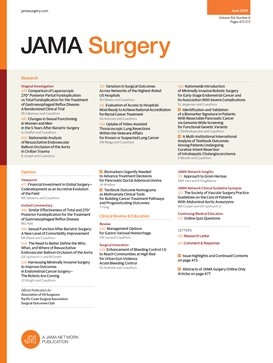Reoperation for Chronic Postoperative Inguinal Pain
IF 14.9
1区 医学
Q1 SURGERY
引用次数: 0
Abstract
ImportanceWith a decrease in recurrence since modern hernia repair, chronic postoperative inguinal pain is the most important patient-centered outcome. Surgical intervention is often necessary in cases refractory to conservative measures but remains understudied.ObjectiveTo evaluate causes of refractory chronic postoperative inguinal pain and review the operative approaches used to treat patients who experience it.Design, Setting, and ParticipantsThis case series used electronic medical record data from a single-institution hernia center during the period August 1, 2009, to September 17, 2024. Participants were adult patients who underwent surgery for chronic postoperative inguinal pain; those who underwent surgeries during which the inguinal canal was not entered or involved were excluded. Patients were followed up from their remedial surgery date to their most recent surgeon follow-up visit date.ExposuresRemedial surgical approach (laparoscopic, robotic, open, combined), use of mesh, nerve management, and mesh excision.Main Outcomes and MeasuresThe primary outcome was subjective pain improvement after remedial surgery; other outcomes were postoperative complications and need for additional operations.ResultsA total of 818 adult patients underwent surgery for chronic postoperative inguinal pain (median [IQR] age, 53 [42-64] years; 193 [23.6%] were female and 625 [76.4%] male). Among them, 779 patients (95.2%) underwent previous inguinal repair with nearly half (49.3%) undergoing 2 or more surgeries. Of remedial surgeries, 221 (27.0%) were open alone, 113 (13.8%) were laparoscopic alone, 57 (7.0%) were robotic alone, 349 (42.7%) were hybrid open and laparoscopic, and 78 (9.5%) were hybrid open and robotic. Seven hundred thirty patients (89.2%) underwent a neurectomy, with triple neurectomies in 401 surgeries (54.9%). Mesh was removed in 559 patients (68.3%). Among patients with at least 5 days of postoperative follow-up, inguinal pain improved in 798 patients (98.5%), with 560 patients (70.2%) reporting more than a 50% reduction in inguinal pain and 226 (28.3%) reporting a 50% or smaller improvement. Twelve patients (1.5%) had no significant improvement in subjective pain. Forty-two patients (5.1%) experienced complications.Conclusions and RelevanceChronic postoperative inguinal pain is a common, debilitating complication of inguinal hernia repair. Remedial surgery is complex, but tailored surgical approaches that consider neurectomy, mesh excision, and recurrent inguinal hernia repair can be safe and effective in experienced centers.慢性腹股沟术后疼痛的再手术治疗
随着现代疝修补术后复发的减少,术后慢性腹股沟疼痛是最重要的以患者为中心的预后。手术干预往往是必要的情况下,顽固的保守措施,但仍未充分研究。目的探讨难治性慢性腹股沟术后疼痛的原因,探讨治疗难治性慢性腹股沟疼痛的手术入路。设计、环境和参与者本病例系列使用2009年8月1日至2024年9月17日期间来自单一机构疝气中心的电子病历数据。参与者是因慢性术后腹股沟疼痛而接受手术的成年患者;那些在手术过程中没有进入或涉及腹股沟管的患者被排除在外。患者从他们的补救手术日期到他们最近的外科医生随访日期进行随访。暴露于补救手术入路(腹腔镜、机器人、开放、联合)、补片的使用、神经管理和补片切除。主要结局和测量方法:主要结局为手术后主观疼痛的改善;其他结果是术后并发症和需要额外的手术。结果共有818例成人患者因慢性术后腹股沟疼痛接受手术治疗(中位[IQR]年龄53[42-64]岁;其中女性193例(23.6%),男性625例(76.4%)。其中779例(95.2%)患者既往行腹股沟修复,近一半(49.3%)患者既往行2次及以上手术。在补救性手术中,单纯开放221例(27.0%),单纯腹腔镜113例(13.8%),单纯机器人57例(7.0%),单纯开放与腹腔镜混合349例(42.7%),单纯开放与机器人混合78例(9.5%)。730例患者(89.2%)接受了神经切除术,其中401例(54.9%)接受了三重神经切除术。559例(68.3%)患者取下补片。在术后随访至少5天的患者中,798例(98.5%)患者腹股沟疼痛得到改善,其中560例(70.2%)患者腹股沟疼痛减轻50%以上,226例(28.3%)患者腹股沟疼痛减轻50%或更小。12例患者(1.5%)主观疼痛无明显改善。42例(5.1%)出现并发症。结论及意义:腹股沟疝修补术后慢性疼痛是一种常见的、使人衰弱的并发症。补救手术是复杂的,但在经验丰富的中心,考虑神经切除术、网片切除术和复发性腹股沟疝修补的量身定制的手术方法是安全有效的。
本文章由计算机程序翻译,如有差异,请以英文原文为准。
求助全文
约1分钟内获得全文
求助全文
来源期刊

JAMA surgery
SURGERY-
CiteScore
20.80
自引率
3.60%
发文量
400
期刊介绍:
JAMA Surgery, an international peer-reviewed journal established in 1920, is the official publication of the Association of VA Surgeons, the Pacific Coast Surgical Association, and the Surgical Outcomes Club.It is a proud member of the JAMA Network, a consortium of peer-reviewed general medical and specialty publications.
 求助内容:
求助内容: 应助结果提醒方式:
应助结果提醒方式:


